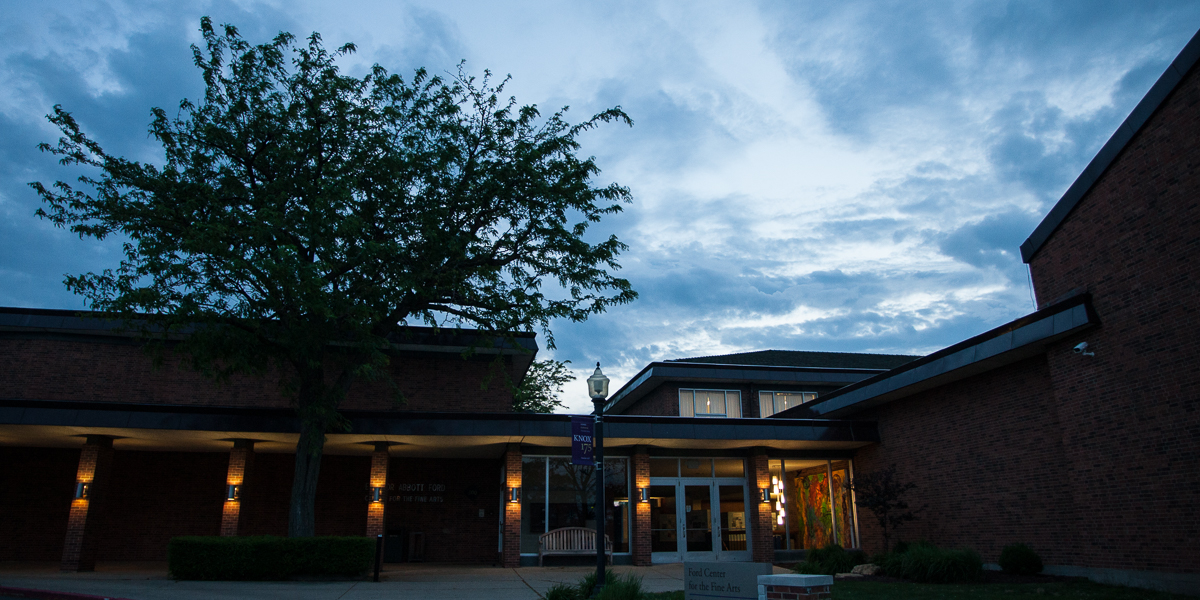By Laura Pochodylo '14
Squirrels have become iconic around the Knox College campus, even appearing with Abraham Lincoln on windows that were painted for Homecoming, but it is surprising how little we know about them.
Steve Galdek, a biology major from Chicago Ridge, Illinois, is changing that with his senior research project on the winter habits of Knox's most popular species on campus, the fox squirrel.
Fox squirrels do not hibernate. Galdek has estimated that 45 to 60 fox squirrels call Knox's campus home and spend the winter living in tree nests.
"Essentially, I am asking: How do they survive in the winter?" Galdek said.
Fox squirrels are "amazing organisms," he said. They are the largest tree squirrels in North America, and are able to, as Galdek has found in Galesburg, "thrive in urban environments."
Galdek originally was interested in pursuing research about the squirrels because of his background as a biology major. He was also inspired by his experiences of working with animals in classes taught by associate professors of biology James Mountjoy and Jennifer Templeton.
"I am very interested in ecology, so most of the biology classes I take revolve around that," he said. "Knox has really inspired me to have an appreciation for all living things, and the enthusiasm from my professors has played a pivotal role in me wanting to learn more about the environment around me."
Galdek spent the six weeks of winter break in Galesburg, mapping the locations of trees and squirrel nests. He used GPS (Global Positioning System) equipment to pinpoint the location of each tree and nest, and he then created a computer-generated map of the locations using GIS (Global Information System).
"This is giving me a better understanding on how to do field research and what to expect when studying a living organism," Galdek said. "It is giving me more experience with GIS, GPS, identifying trees, and getting a better understanding about how organisms interact with the world around them."
Spending winter break with his research "brought me close to the organism that I'm studying. It was like I was surviving winter with them."
There have been surprises for Galdek along the way. He once thought squirrels might enjoy nesting in conifer trees that keep their leaves for the winter, such as the pine trees near the Knosher Bowl, because they offer protection from wind and additional cover. But the squirrels seem to prefer "big, open trees," like oak trees.
"Their food source is from deciduous trees, so they are willing to sacrifice that cover and safety for the convenience of being near their food," Galdek said.
Galdek has found that the squirrel nests around campus are more complex than one might imagine, and they are numerous. A large gingko tree outside of Seymour Library serves as the home for 12 squirrel nests.
"Each squirrel has an individual nest, but then a (door-like) hatch to an additional getaway nest," Galdek said. "They look like a bunch of leaves, but they're actually very intricate, interwoven with branches so that no heat gets out and with little hatches that they built."
Below, Steve Galdek counts squirrels on the ground, points out nests in trees on campus. More photos on Flickr...
While Galdek is finding his research very interesting, he also believes it can benefit the "city as a whole."
"Mapping the trees and the nests will create a database on where to build," he said, which he believes could be a resource for deciding where to put future buildings in order to avoid damage from squirrels.
In addition to focusing on where the Knox squirrels live and store their food, Galdek also studies how they interact with the large flocks of crows on campus that also roost in the trees during winter.
Crows avoid roosting in trees with a large number of squirrels, Galdek has found. He also designed an experiment involving the two competitors to examine how far and how long squirrels will work to get food -- including digging for cached nuts -- before giving up on a particular item.
"I'll set out two trays, each with sand and sunflower seeds. One of the trays will have a crow decoy," Galdek said. "I anticipate the squirrels will forage for longer on the regular tray, (while) they might take a few pieces and leave quickly from the one with the decoy."
Galdek is aware of the squirrels' "pretty iconic" status on campus, and, like many Knox students, he is fond of them.
"They're wonderful, important organisms," he said. "This research is really making me feel like a biologist."








 Wonderful, important organisms... This research is really making me feel like a biologist - Steve Galdek
Wonderful, important organisms... This research is really making me feel like a biologist - Steve Galdek

